Nepal Sutras, originally written on cloth banners, were transmitted to other regions of the world as prayer flags. Legend ascribes the origin of the prayer flag to the Gautama Buddha, whose prayers were written on battle flags used by the Hindus against their adversaries, the Asuras.
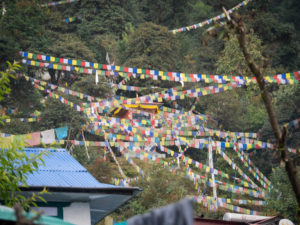
During the Cultural Revolution, prayer flags were discouraged but not entirely eliminated. Many traditional designs may have been lost. Currently, different styles of prayer flags can be seen all across the Tibetan region.
There are two kinds of prayer flags: horizontal ones, called Lung ta meaning “Wind Horse” in Tibetan, and vertical ones, called Darchog meaning “Flagstaff”.
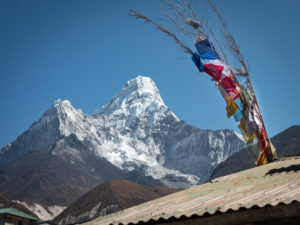
Lung ta (horizontal) prayer flags are of square or rectangular shape and are connected along their top edges to a long string or thread. They are commonly hung on a diagonal line from high to low between two objects (e.g., a rock and the top of a pole) in high places such as the tops of temples, monasteries, stupas, and mountain passes.
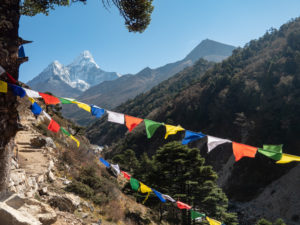
Darchog (vertical) prayer flags are usually large single rectangles attached to poles along their vertical edge. These flags are commonly seen in the ground, on mountains, in cairns, and on rooftops.
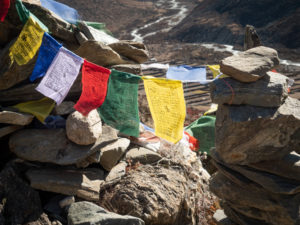
Traditionally, prayer flags come in sets of five: one in each of five colors. The five colors are arranged from left to right in a specific order: blue, white, red, green, and yellow. The five colors represent the five elements. Blue symbolizes the sky and space, white: the air and wind, red: fire, green: water, and yellow: earth. According to Traditional Tibetan medicine, health and harmony are produced through the balance of the five elements.
In addition to mantras, prayers for a long life of good fortune are often included for the person who mounts the flags.
Traditionally, prayer flags are used to promote peace, compassion, strength, and wisdom. The flags do not carry prayers to gods, which is a common misconception; rather, it is believed the prayers and mantras will be blown by the wind to spread the good will and compassion into all pervading space. Therefore, prayer flags are thought to bring benefit to all.
The prayers of a flag become a permanent part of the universe as the images fade from exposure to the elements. Just as life moves on and is replaced by new life, Tibetans renew their hopes for the world by continually mounting new flags alongside the old. This act symbolizes a welcoming of life’s changes and an acknowledgment that all beings are part of a greater ongoing cycle.
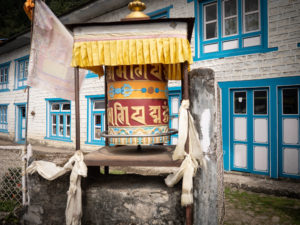
Prayer wheels were not as common as the flags so they were more of a treat when we ran across them.
A prayer wheel is a cylindrical wheel on a spindle made from metal, wood, stone, leather or coarse cotton. Traditionally, the mantra “Om Mani Padme Hum” is written in the Newari language of Nepal, on the outside of the wheel. At the core of the cylinder is a “Life Tree” often made of wood or metal with certain mantras written on or wrapped around it. Many thousands (or in the case of larger prayer wheels, millions) of mantras are then wrapped around this life tree. According to the Tibetan Buddhist tradition based on the lineage texts regarding prayer wheels, spinning such a wheel will have much the same meritorious effect as orally reciting the prayers.
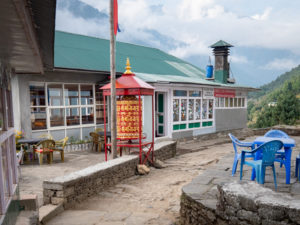
Prayer Wheels are used to accumulate wisdom and merit (good karma) and to purify negativities (bad karma). The practitioner most often spins the wheel clockwise, as the direction in which the mantras are written is that of the movement of the sun across the sky.
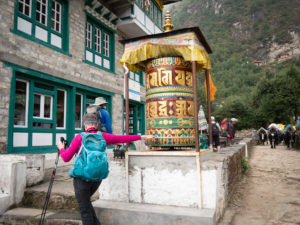
As the practitioner turns the wheel, it is best to focus the mind and repeat the “Om Mani Padme Hum” mantra. Not only does this increase the merit earned by the wheel’s use, but it is a mind-stabilization technique that trains the mind while the body is in motion. Each revolution is as meritorious as reading the inscription aloud as many times as it is written on the scroll, and this means that the more Om Mani Padme Hum mantras that are inside a prayer wheel, the more powerful it is.
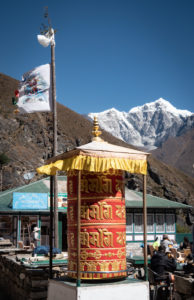
It is best to turn the wheel with a gentle rhythm and not too fast or frantically. While turning smoothly, one keeps in mind the motivation and spirit of compassion and bodhichitta (the noble mind that aspires to full enlightenment for the benefit of all beings). The benefits attributed to the practice of turning the wheel are vast. Not only does it help wisdom, compassion, and bodhichitta arise in the practitioner, it also enhances siddhis (spiritual powers such as clairvoyance, precognition, reading others thoughts, etc.). The practitioner can repeat the mantra as many times as possible during the turning of the wheel, stabilizing a calm, meditative mind. At the end of a practice session, there is a Tibetan Buddhist tradition of dedicating any accumulated merits that one may have gathered during practice to the benefit of all sentient beings. Then Om Ah Hum 3 times. This is customary with Tibetans upon completing any Buddhist practice, including the practice of the prayer wheel.
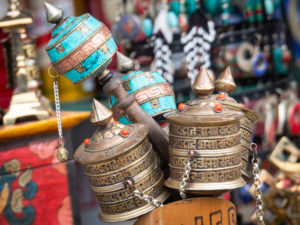
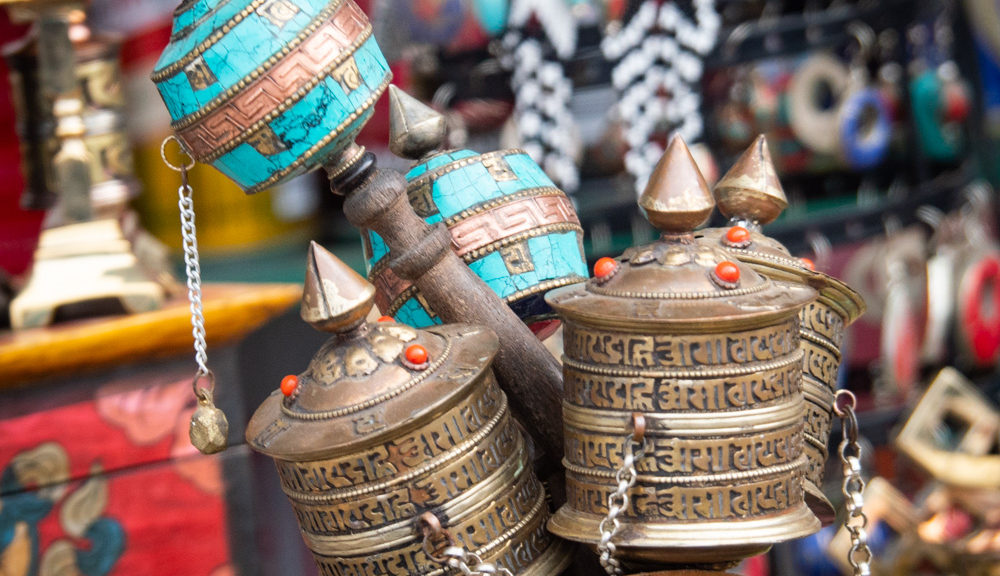
I love learning new things and your blogs provide that learning every week!
Many thanx!
Sharing your knowledge and photos of the prayer flags and wheels must give you excellent karma! I’m loving your fantastic blogs.
Thank you! I’m loving every episode of this amazing journey!